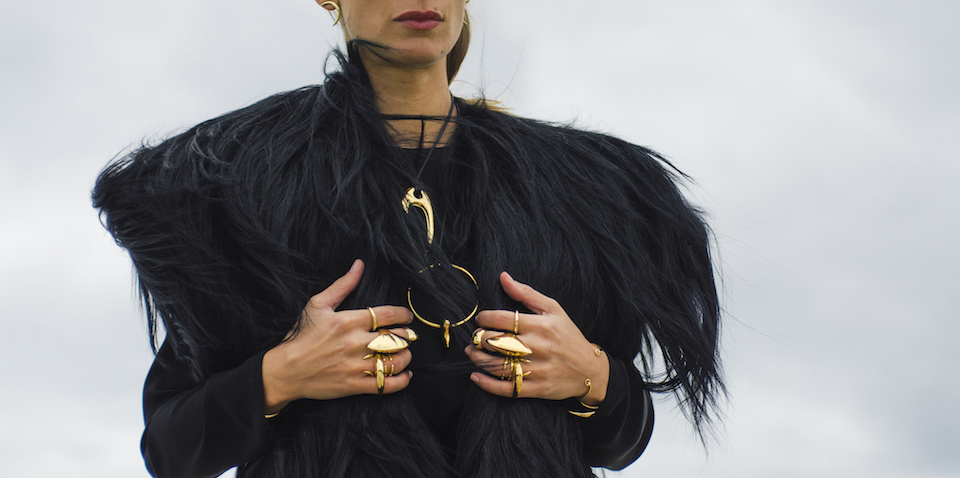Jewelry master Jovana Djuric opens up about creativity, success & home
For Jovana Djuric, founder and creative director of namesake jewelry brand Jovana Djuric, jewelry is about more than looking stylish. Through her lifelong love of art, she discovered a way to channel empowerment and core selfhood through her distinctive designs.
Djuric is a Serbian artist who immigrated to New York City in 2000 to study jewelry design at the Fashion Institute of Technology (FIT). She gained experience in the industry with positions at Tiffany and Co., Philip Crangi, Givenchy and Robert Lee Morris before starting her own line in 2015.
Although she has called New York home for many years, Djuric took a break from the city in 2019 and spent the year in Oaxaca, Mexico, where she worked with Zapotec women to learn traditional jewelry design techniques. Now, she is considering a new base in Tulum, Mexico, to “broaden her sense of home.” Here is what she had to share about her life and creative process.
What adjectives would you use to describe your art?
It is funny, I think of my jewelry less through the adjectives and more through the nouns. I see them as objects that have the embedded power; they are the reminders of your core self and your ally on your journey of reclaiming that power. As women today, the path we walk is not an easy one. This is not only about women being respected in the business, being entrepreneurial and able to raise the funds or earning more than 70 cents on the dollar. This is way deeper. The shift is a very beautiful tectonic shift of our awakening.
Does your Serbian heritage shape your eye for design or artistic vision in any way?
Being Serbian and coming from the Balkans, I was always thoroughly immersed in a multitude of influences, from Greco-Roman to Byzantine to Middle Eastern and Arabic, Russian and even Western European. I always feel I am working in a broad field of reference, and I am constantly in a dialog with the art and craftsmanship that came before me. I am always thinking about the future, and I am trying to bring forward this sense of a long-forgotten past.
What are your favorite pieces to wear?
Rings, rings, rings — I love stacking my slices in all the different lengths. I love Horus Blanc Slate that has more volume to it and adds nice play to the stack. I love my rose cut, diamond-encrusted stack ring. At the end, I usually add my frontal hoop earrings.
What brought you to Oaxaca, Mexico?
It was time to try something new. I left not knowing what I was going to find and how it was going to feel. What I found was a totally new reality that had no connection to my previous life at all. It was equal parts exhilarating and totally confusing.
What did you learn from your experiences working with the Zapotecas? Do you still have a connection to them?
I spent time teaching Zapoteca women how to make jewelry in the jungle above Puerto Escondido. They would show up with their kids, and I’d have to quickly give the kids something to do as well. Women would work with so much precision and dedication and honor. It was beautiful to witness. The sense of grounding and centered-ness that they brought to the table was so inspiring to me. I soon realized that I wasn’t really teaching them things but rather providing a space and time for them to remember what they already knew. And yes, I still have a connection with them and plan on going to work with them again very soon.
Many models and celebrities have worn your designs — was there a moment when you felt that you had reached success? What was it, and what did it feel like?
As I am going back through those moments, I am realizing that it wasn’t really the celebrities and models that gave me the sense of the achievement but rather the personal responses I got to my emails I sent to the editors introducing my collection. My first desk side with Vogue was in 2015 when I only had my first four Horus Origin rings. Another one was meeting Edward Enninful, who at the time was the editor-in-chief of W magazine, and him personally requesting Horus for the Anniversary Issue he shot with Rihanna.
What inspired the Horus collection?
Looking back, I can see that throughout my life, I was always drawn to horn-like shapes; whether it was an actual horn, a bone, a claw, a crescent moon or a flower bud, there was something about that form that was always suggesting an idea of growth to me.
One day, when I was ready to unleash this feeling of completing something that was thoroughly mine, I just sat at the bench, and I carved the horn-like shapes and rings for days. I didn’t have a plan, but I had a very clear sense of where I was going.
What do you think sets Horus apart from other jewelry collections?
I am a sculptor and a master jeweler; I spent more than twelve hours a day in the studio for many, many years. I learned from the best teachers across many traditions; I take no shortcuts. I hone in on and refine my pieces over days and weeks. I carve them and try them on; I adjust them; I carve more; I try them on again. I create a relationship between the object, my body and my movement. I don’t think I am making jewelry in a sense of the decoration — I am making an integral part of your body, and it has to make sense with the way you move, the way you are, the way you’re intending to be.








